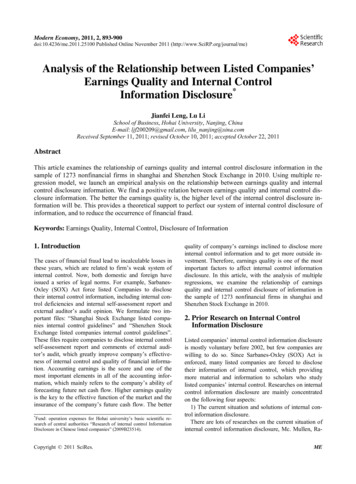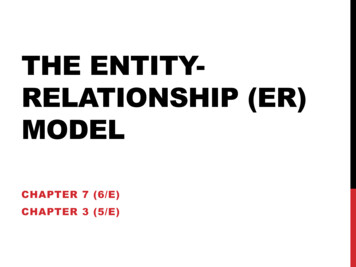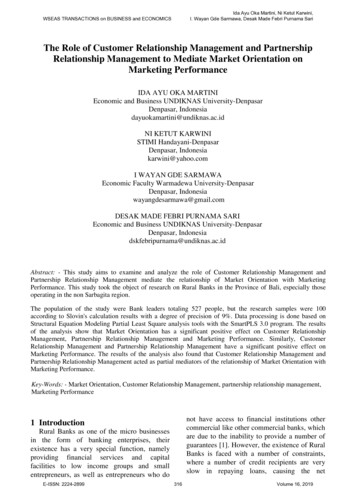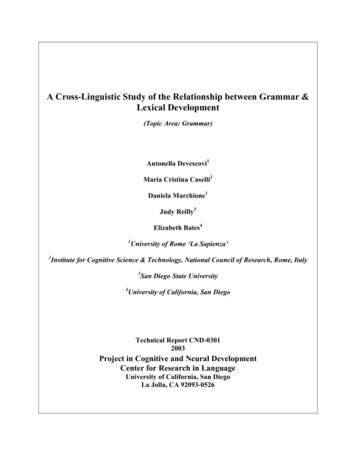
Transcription
893Modern Economy, 2011, 2, 893-900doi:10.4236/me.2011.25100 Published Online November 2011 (http://www.SciRP.org/journal/me)Analysis of the Relationship between Listed Companies’Earnings Quality and Internal ControlInformation Disclosure*Jianfei Leng, Lu LiSchool of Business, Hohai University, Nanjing, ChinaE-mail: ljf200209@gmail.com, lilu nanjing@sina.comReceived September 11, 2011; revised October 10, 2011; accepted October 22, 2011AbstractThis article examines the relationship of earnings quality and internal control disclosure information in thesample of 1273 nonfinancial firms in shanghai and Shenzhen Stock Exchange in 2010. Using multiple regression model, we launch an empirical analysis on the relationship between earnings quality and internalcontrol disclosure information. We find a positive relation between earnings quality and internal control disclosure information. The better the earnings quality is, the higher level of the internal control disclosure information will be. This provides a theoretical support to perfect our system of internal control disclosure ofinformation, and to reduce the occurrence of financial fraud.Keywords: Earnings Quality, Internal Control, Disclosure of Information1. IntroductionThe cases of financial fraud lead to incalculable losses inthese years, which are related to firm’s weak system ofinternal control. Now, both domestic and foreign haveissued a series of legal norms. For example, SarbanesOxley (SOX) Act force listed Companies to disclosetheir internal control information, including internal control deficiencies and internal self-assessment report andexternal auditor’s audit opinion. We formulate two important files: “Shanghai Stock Exchange listed companies internal control guidelines” and “Shenzhen StockExchange listed companies internal control guidelines”.These files require companies to disclose internal controlself-assessment report and comments of external auditor’s audit, which greatly improve company’s effectiveness of internal control and quality of financial information. Accounting earnings is the score and one of themost important elements in all of the accounting information, which mainly refers to the company’s ability offorecasting future net cash flow. Higher earnings qualityis the key to the effective function of the market and theinsurance of the company’s future cash flow. The better*Fund: operation expenses for Hohai university’s basic scientific research of central authorities “Research of internal control InformationDisclosure in Chinese listed companies” (2009B23514).Copyright 2011 SciRes.quality of company’s earnings inclined to disclose moreinternal control information and to get more outside investment. Therefore, earnings quality is one of the mostimportant factors to affect internal control informationdisclosure. In this article, with the analysis of multipleregressions, we examine the relationship of earningsquality and internal control disclosure of information inthe sample of 1273 nonfinancial firms in shanghai andShenzhen Stock Exchange in 2010.2. Prior Research on Internal ControlInformation DisclosureListed companies’ internal control information disclosureis mostly voluntary before 2002, but few companies arewilling to do so. Since Sarbanes-Oxley (SOX) Act isenforced, many listed companies are forced to disclosetheir information of internal control, which providingmore material and information to scholars who studylisted companies’ internal control. Researches on internalcontrol information disclosure are mainly concentratedon the following four aspects:1) The current situation and solutions of internal control information disclosure.There are lots of researches on the current situation ofinternal control information disclosure, Mc. Mullen, RaME
894J. F. LENGgahunandan and Rama [1] studied 4154 companies during 1989-1993, suggesting that only 26.5% companiesare willing to disclose their internal control information,and that only 10.5% provide their internal control reportamong those companies with deficiencies on their financial reports. It shows that the proportion of companiesvoluntarily disclosing their internal control informationis little, and that the companies with deficient financialreport are more unwilling to provide the internal controlself-assessment report. Hermanson [2] also did corresponding empirical research on listed company’s internalcontrol information disclosure and got the same conclusion. Minghui Li [3] and Dongmei Qin [4] made relatedresearches on the current situation of internal controlinformation disclosure. They believed that current listedcompanies’ enthusiasm of disclosing internal control information is not strong, and much internal control information was not substantial but formal. Minghui Li [3]also drawn on the experiences of the United States ininternal control information disclosure, and provided aseries of suggestions and measures of improving internalcontrol information disclosure. Hua Li, Lina Chen [5],Xiaofeng Dai and Jun Pan [6] analyzed the current situation of internal control information disclosure with internal control theories, and pointed out the problems andput forward the corresponding solution. Xinhua Dai andQiang Zhang [7] mainly did the research on listed banks’internal control information disclosure, finding that ourlisted banks’ system of internal control information disclosure is not standardized and sufficient. They interpreted the corresponding requirements of the US internalcontrol information disclosure set by “Sarbanes-OxleyAct”, suggesting China to promote the improvement oflisted banks’ internal control information step by step.According to relevant provisions of internal control information disclosure required by “Shanghai Stock Exchange Guidelines” and “The Notice on Listed Companies’ Annual Report in 2006”, Youhong Yang and WeiWang [8] analyzed the internal control information disclosure of listed companies on Shanghai Stock Exchangein 2006 with descriptive statistics, and found manyproblems.2) Impact factors of internal control information disclosure.Bronson, carcello, Raghunandan [9] and Doyle, Ge,McVay [10] suggested that there is a correlation betweencorporate identity and internal control information disclosure. Company size, the proportion of institutionalinvestor holding, the number of audit committee and thespeed of earnings growth have impact on internal controlinformation disclosure. Many other experts did empiricalstudy on such question. Ge and McVay [11] used a survey method to analyze the sample, discovering that theCopyright 2011 SciRes.ET AL.disclosure of material defects is related to the complexityof the company but there is no direct correlation withcompany size and profitability. Jifu Cai [12] made arelevant empirical study of A-share listed companies tofind impact factors of listed companies’ internal controlinformation disclosure. The results showed that the companies with a better operating performance and higherreliability of financial report are more inclined to disclose its internal control information, and vice versa.This indicates that the company’s operating performanceand reliability of financial report affect the listed companies’ internal control information disclosure. Adrew J.Lcone [13] selected listed companies who disclosed material defects of their internal control information in theirannual reports as samples to study the impact factors ofinternal control information disclosure. The results showthat the complexity of corporate structures, the changesin company structure and the inputs to internal controlare all the impact factors of internal control informationdisclosure. Shaoqing Song and Yao Zhang [14] studiedA-share listed companies on Shanghai and ShenzhenStock Exchange from 2006 to 2007, finding that there isa correlation between corporate governance characteristics and internal control information disclosure. Auditcommittee, annual statistics, company size and the placeof listing have a significant impact on internal controlinformation disclosure. Bin Wang and Huanhuan Liang[15] studied 1884 listed companies on Shenzhen StockExchange between 2001 and 2004. They made use oftheir rating reports of information disclosure quality toexamine the inherent relationship between listed companies’ corporate governance characteristics, characteristicsof operating condition and information disclosure quality,finding that corporate governance characteristics andcharacteristics of operating condition have a certain impact on internal control information disclosure.3) The cost of internal control information disclosure.The studies on the cost of internal control informationdisclosure are not very much. J. Efrim, Boritz, PingZhang [16] thought that the costs of disclosing internalcontrol information is enormous, and the managementdid not believe that the benefits of internal control information disclosure would surpass the correspondingcosts. Maria [17] analyzed the sample which disclosestheir internal control information in accordance withSEC requirements, primarily study the relationship between the costs of disclosing internal control informationand the effectiveness of the internal control system. It isfound that the cost of disclosing deficiencies of internalcontrol information is far more than that of defect-free.4) Correlation between internal control and earningsquality.There are many researches on the correlation betweenME
J. F. LENGinternal control and earnings quality. Doyle [11] studiedthe relationship between internal control and earningsquality, and found that internal control is a motivation ofearnings quality. The studies of Chan [18] and Goh andLi [19] are similar. Chan [18] discovered that earningsmanagement of those who disclose the material defectsof internal control has a higher degree but the return oninvestment is very low. Goh and Li’s [19] also found thatcompany’s earnings stability can be increased after improving the defects of internal control. Lobo and Zhou[20] made a comparison on companies’ discretionaryaccruals between before implementing “Sarbanes-OxleyAct” and after implementing it, finding that companies’discretionary accruals decreased a lot after the implementation of “Sarbanes-Oxley Act”. Doyle, Ge andMcvay [10] divided the internal control defects into twoaspects: corporate level and account level, finding thatinternal control defects on corporate level is influential toearnings quality, but there is no correlation between internal control defects on account level and earnings quality. Guoqing Zhang [21] selected non-financial A-sharelisted companies in 2007 as a research object to study theinternal control quality on earnings quality. The resultshave shown that there is no close link between high quality internal control and earnings quality, but company’scharacteristics and corporate governance factors mayaffect internal control quality and earnings quality systematically. Chunsheng Fang et al. [22] used questionnaire survey to examine the relationship between internalcontrol system and financial reporting quality, findingthat financial reporting quality improved after implementation of internal control system. Jun Zhang andJunzhi Wang [23] selected listed companies on ShanghaiStock Exchange in 2007 as sample, and used adjustedJones model to calculate discretionary accruals andfound that discretionary accruals significantly reducedafter the review of internal control. Shengwen Xie andWenhai Lai [24] selected A-share listed companies onShanghai Stock Exchange in 2007 and 2008 as samples.They analyzed the relationship between internal controldeficiencies and earnings quality by using a paired study,and found that listed companies’ internal control information disclosure had an effect on earnings quality.Based on the above studies, we can see that internalcontrol gets more attention after the promulgation of“Sarbanes-Oxley Act”. Current researches centralize onthe defects of existing laws and regulations, the currentsituations of listed companies’ internal control information disclosure, the relationship between listed companies’ internal control information disclosure and theiroperating conditions, financial report quality and earnings quality. Among the current studies, most have focused on descriptive statistics and the relationship beCopyright 2011 SciRes.ET AL.895tween internal control quality and earnings quality, whilethere is no study use earnings quality as explanatoryvariable to reflect its effect on internal control information disclosure. Therefore, this article uses earnings quality as main explanatory variable and disclosure of internal control as the dependent variable to do empiricalstudy, which compensate for the lack of current researchto some extent.3. Method3.1. HypothesisHypothesis: the better the quality of earnings is, thehigher the level of internal control information disclosurewill be.According to agency theory and signaling theory,corporate trustee has obligation to report relevant information to the corporate capital owners, which give helpto the operation of business. In the process of reporting,corresponding information is to pass the corporate relevant signal to the capital market. The signal can make theoperator affect the flow of resources in capital market ina certain extent to improve the enterprise’s interests.There is the mutually reinforcing relationship betweeninternal control information disclosure and the quality ofearnings. A company that can fully disclose its information of internal control means that its managers have agood description of ethics. Meanwhile, a company thatcan take the initiative to show its internal control information in detail indicates that its company has a higherself-confidence, which will attract more capital marketresources, increase its cash flow, enhance the quality ofearnings, and improve management capabilities. Conversely, companies with good earnings quality willchoose to voluntarily disclose their information of internal control in detail. They can distinguish themselves tothe companies with inferior earnings quality and getmore favor from investors.3.2. Variable Selection and Definitions3.2.1. Dependent VariableIn this paper, we use internal control index to substituteinternal control information disclosure (ICD) to test thefull of detail of internal control information disclosure.The selection criteria of internal control information disclosure item are “listed company’s internal control guidelines on Shanghai Stock Exchange” and “listed company’s internal control guidelines on Shanghai StockExchange”. The eight items of information disclosure are:internal environment, risk assessment, control activists,information and communication, internal oversight, inME
J. F. LENG896ternal control deficiencies, internal evaluation and external evaluation. The eight items cover almost all majorinformation that stakeholders needed and reflect the realsituation of internal control by a large margin, which canaccurately reflect the level of companies’ internal controlinformation disclosure. The specific method of operationis scoring method, that is, make scores to the eight items.Disclose one item gets one point, otherwise gets zero,then the sum of the eight items is the internal controlinformation disclosure index.3.2.2. Independent VariablesThe company’s earnings quality is the company’s accounting earnings quality. Acruals quality is widely usedas a proxy variable of earnings quality. Healy [25] divided accruals into discretionary accruals andnon-discretionary accruals. Many scholars believe thatthe level of discretionary accruals could measure thelevel of earnings quality. This article makes discretionaryaccruals as an alternative to earnings quality to be estimated in the modified cross-section Jones Model.TAi ,t Ai ,t 1 1 1 Ai ,t 1 2 REVi ,t RECi ,t Ai ,t 1 3 PPEi ,t Ai ,t 1 ei ,tTAi ,t : the current total accruals of company i,TAi ,t RETi ,t CFOi ,t( RETi ,t means the current net profits of company i,CFOi ,t means the current cash flow from operating activities of company i).Ai ,t 1 : the total assets of company i at the end of lastyear. REVi ,t : the margin of the current main business in-ET AL.come and the last year’s main business income in company i. RECi ,t : the margin of the current accounts receivable balance and the last year’s accounts receivable balance in company i.PPEi ,t : the current total fixed assets of company i.ei ,t : residuals, controllable profits is its absolute value. 1 , 2 , 3 : general parameters, can be estimated bybasic Jones model with the year’s data:TAi ,t Ai ,t 1 1 1 Ai ,t 1 2 REVi ,t Ai ,t 1 3 PPEi ,t Ai ,t 1 3.2.3. Control VariablesIn addition to the study of the earnings quality on internal control information disclosure, there is a lot of researches about the impact factors of internal control information disclosure. Disclosure of internal control information can’t be completely attributed to earningsquality. Many other factors should be taken into consideration as well. Bronson, Carcello, Raghunandan [9] andDoyle, Ge, McVay [10] thought that company’s characteristics are related to internal control information disclosure. Company size, the stake holding proportion ofinstitutional investors, the number of attending meetingof audit committee and the income growth all affect theinternal control information disclosure. Shaoqing Songand Yao Zhang [14] also discovered that there is correlation between corporate governance characteristics andinternal control information disclosure. Therefore, thisarticle selects controlling variable from the basic characteristics of company, company performance and corporate governance characteristics. The selected control variables are classified in Table 1.Table 1. Variables and their measurement method.Nature of VariablesName of VariablesMeasurement of VariablesSymbols of VariablesScore each item of internal control information disclosure,and then sum themICDEarnings QualityCalculate operational accruals by using Modified JonesModelEQReturn on EquityNet profits/[(Balance of Shareholders’ Equity at the End ofPeriod Balance of Shareholders’ Equity at the End ofPeriod/2] 100%ROETotal Liabilities/Total Assets 100%DTANet Income after Tax/All Ordinary SharesEPSNumber of Board DirectorsBSNumber of Independent Director/Total Number of BoardDirectorsIDProportion of the top five shareholdersOCDummy Variable, Establishment 1; 0 OtherwiseIACDependent Variables Internal Control Information DisclosureIndependent VariablesThe debt-to-asset ratioEarnings Per ShareControlling VariablesBoard SizeThe Proportion of Independent DirectorsOwnership ConcentrationInternal Audit AgencyCopyright 2011 SciRes.ME
J. F. LENG1) Return on Equity (ROE):ROE is rate of return on common stockholders’ equity.ROE reflects the income of company’s net assets and thecompany’s profitability. The level of ROE reflects thelevel of strength of corporate profitability. Jifu Cai [12]believed that listed companies with good operating performance tend to disclose their internal control information.2) The Debt-to-Asset Ratio (DTA).DTA is the reflection of the comprehensive ability.The level of the DTA reflects the strength of company’spredictive power. Hossain [26] studied the impact factorsof internal control information disclosure twice, Hefound that debt ratio were positively correlated with thelevel of disclosure. Thus this article chooses DTA as oneof control variables.3) Earnings per Share (EPS).It is an important indicator of measuring corporation’soperating performance. Lang and Lundholm’s [27] studyshowed that the better the company’s operating performance is, the higher level of internal control information disclosure will be. Thus this article chooses EPS asone of control variables.4) Board Size (BS).BD is an important feature of corporate governance.The size of board may also affect the disclosure of internal control information. Yermack [28] used the data of500 listed companies in US published on “Forbes” magazine between 1981 and 1991. They made a conclusionthat the larger the BD is, the worse the corporate performance will be, so it can’t play a good role in the disclosure of information outside.5) The Proportion of Independent Directors (ID).Independent directors are always independent andgenerally the experts in economic, legal, accounting andothers, they can express their authoritative opinions onthe information listed company should disclosure bystanding on the position of investors. They are morelikely to affect decision-making of information disclosure and make them inclined to disclose internal controlinformation.6) Ownership Concentration (OC).Ownership concentration plays an important role ininternal control information disclosure. Wei Zuo and YeQiao [29] believed that the higher the ownership concentration is, the greater the risk of major shareholdersstealing the interests of minority shareholders will be.Then companies tend to disclose more detailed information to make users understand more about corporatebusiness situations and to protect the interests of minority shareholders. In addition, Hossain [26] found thatthere is a positive relationship between ownership concentration and the level of the disclosure of internal conCopyright 2011 SciRes.ET AL.897trol information. Thus the ownership concentration shouldbe one of controlling variables.7) Internal Audit Agency (IAC).In general, the companies established IAC may attachmore importance to the internal control information disclosure and reduce various types of risk.3.3. Sample SelectionThis article selects 1689 listed companies of A-sharemarket main board in Shanghai and Shenzhen Stock Exchange in 2010, to ensure the validity of data, removing39 financial and insurance companies and 221 companieslisted in the year and 61 companies of delisting and suspension of listing and 95 companies of missing data.The indicators data of sample are from Shanghai StockExchange (http://www.sse.com.cn), Shenzhen Stock Exchange (http://www.szse.cn), Huge influx of informationnetwork (http://www.cninfo.com) and Ruisi Database(http://www.resset.cn). Data processing using statisticsoftware spss 16.0.3.4. Model SetThis article chooses multiple linear regression models:ICD 0 1 EQ 2 ROE 3 DTA 4 EPS 5 BS 6 ID 7 OC 8 IAC e 0 is constant term, i (i 1, 2,3, ,8) is model regression coefficients, e is residuals.4. Empirical Analysis4.1. Internal Control Information DisclosureIndexThis article uses internal control information disclosureindex to measure the listed company’s internal controlinformation disclosure. According to “listed company’sinternal control guidelines on Shanghai Stock Exchange”and “listed company’s internal control guidelines onShanghai Stock Exchange”, the selected eight items areinternal environment, risk assessment, control activists,information and communication, internal oversight, internal control deficiencies, internal evaluation and external evaluation. The results of information disclosure areshown in Table 2.The statistic results shows that there are 468 companies whose ICD equal and less than 4, accounting for36.76%, and 805 listed companies equal and more than 5,accounting for 63.24%. This indicates that most companies strictly perform internal control information discloME
J. F. LENG898Table 2. Internal control information disclosure index.ICDNumber of CompaniesProportion (%) 446836.76 580563.24ET AL.with reality.4.3. Correlation Analysissure. But we can’t ignore the companies that can’t execute their internal control information disclosure.4.2. Descriptive Statistical Analysis of SampleUsing regression model to analyze each variable, thedescriptive analysis results are shown in Table 3.The descriptive statistics results shows that the maximum of ICD is 8, that is to say all eight items are disclosed; the minimum ICD is 1, it reflects that it didn’tbasically disclose the internal control information. Themean is 5.12, which shows that the level of the internalcontrol information disclosure of listed companies isgood overall and basically observe the two “Guidelines”requirements. The minimum and maximum value ofearnings quality has a large gap. The minimum is 0 andthe maximum is 12.62, and the mean is 0.4425. Thestandard value is 0.85258, which shows that differentcompany differs greatly in earnings quality. ROE is from–991.2% to 1295 %. DTA is from 1% to 699.85%. EPSis from –2.48 to 5.35. These big gaps fully reflect thedifference in listed companies’ performance. In the aspect of corporate governance structure, the differences ofall companies are not small. The mean of BS is 12, andthe proportion of ID is about 34.689%. Different company has different OC, the top five shareholders of somecompanies hold nearly 100% shares, which shows thatthe OC of these companies are very high. The mean ofthe proportion of top five shareholders is 49.17%, whichindicates that the OC of the whole listed companies isvery high. As for the establishment of IAC, some companies established and some didn’t, which is in the lineThe correlation analysis of variables and the significancelevel are shown in Table 4.ICD is negatively related to listed company’s EQ andDTA at 1% significance level. The manageability ofprofit has a negative correlation with the level of internalcontrol information disclosure, and that is to say there isa positive relationship between earnings quality and thelevel of internal control information disclosure. DTA isnegatively related to internal control information disclosure, which is contrary to the findings of Hossain’s [26].ICD is positively related to EPS, OC and the establishment of IAC. This shows that the higher the company’sEPS is, the better the company’s performance will be,and then the company is more inclined to disclose itsinternal control information. The major shareholders inthe company with high OC are more likely to steal theinterests of minority shareholders. The company is morewilling to disclose its internal control information in detail. Furthermore, the establishment of IAC can reducethe company’s risk, and this also reflects the attention tointernal control information disclosure. The ICD showsTable 3. Descriptive statistical analysis of variables.Variable’s Name Minimum MaximumMeanStandard 0.49170.16806IAC0.001.000.62370.48464Table 4. Correlation analysis of 0.120**0.0070.028–0.100**0.0110.0010.0091.00** *This table presents the results for correlation analysis of variables. , Denote significance at the 1% and 5% levels, respectively.Copyright 2011 SciRes.ME
J. F. LENGpositive correlation with BS at the 5% significance level.That is to say the company with larger BS is more likelyto disclose its internal control information. In addition,ICD also shows positive correlation with ROE and ID. Acompany with high ROE indicates its good corporateearnings, and then the company will disclose its positiveinformation to attract more investors. Similarly, a company with high proportion of ID can better stand in theposition of investors to express its authoritative opinionof the information that listed company should disclose.They are more likely to affect the decision of informationdisclosure. From the perspective of multi-collinearity,collinearity doesn’t exist if the correlation coefficient isnot greater than 0.8, according to the study of Hossain,Perera and Rahman [30]. From the results of the variables’ correlation analysis, we can see that the correlation coefficient is essentially no more than 0.8. Therefore,we can conclude that there doesn’t exist multi-collinearity in the model of multiple regression.4.4. Analysis of Multiple RegressionRegress the selected sample with per-set model, and theresults are shown in Table 5.1) Test of Goodness of FitThe model of goodness of fit is 0.472, which indicatesthat the explanatory power of regression equation is47.2%. That is to say, EQ, ROE, EPS, DTA, BS, ID, OCand IAC can make 47.2% explanatory to the level ofinternal control information disclosure. Thus this modelhas a strong explanatory power.2) Overall Significance Test of Model.The F-value of this model is 142.893, with 0.000 accompanying probability less than 0.001. The value of Fα(8, 1264) is significantly less than 142.884 at the signifycance level of 1%. This indicates that independent variables have linear regression relationship with dependentvariable. And the regression model is overall significant,which means various factors within model significantlyaffect internal control information disclosure.Table 5. Internal control information disclosure on the impact of earnings quality.Name of 7591.0883.1860.0832.7141.6411.99232.291Adjusted R Square 0.472 F Value 142.884 Sig. 0.000.Copyright 2011 70.000ET AL.8993) Significance Test of Single Regression Coefficient.EQ is through significance test, indicating that EQ oflisted company has a significant impact on internal control information disclosure, which means that the betterthe earnings quality is, the higher level of the internalcontrol disclosure of information will be. So this article’sstudy hypothesis can be accepted. I
nies' internal control information disclosure and their operating conditions, financial report quality and earn-ings quality. Among the current studies, most have fo-cused on descriptive statistics and the relationship be-tween internal control quality and earnings quality, while there is no study use earnings quality as explanatory











